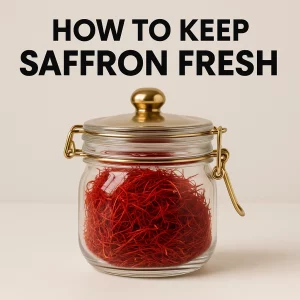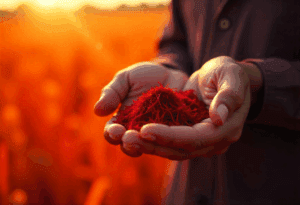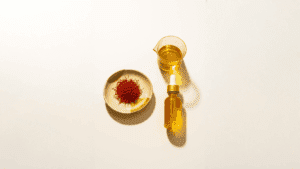Saffron has been called red gold for a reason — its vibrant hue, intoxicating aroma, and healing qualities have made it one of the most coveted ingredients in the world. But behind every thread lies a story of labor, precision, and care that few consumers ever glimpse.
When you purchase a small jar of these delicate crimson threads, you're not just buying a spice. You're investing in centuries of tradition, countless hours of meticulous handwork, and a process that simply cannot be rushed or automated.
A Labor of Love: The Harvest
Saffron comes from the Crocus sativus flower, a delicate purple blossom that blooms only once a year, for just a few weeks in autumn. Each flower produces only three red stigmas — and these must be picked entirely by hand.
Harvesting begins early in the morning, when the flowers are still closed and the stigmas at peak freshness. Skilled workers, often using tweezers or their fingertips, gently pluck the threads one by one, taking care not to damage them.

The timing is critical. Harvest too early, and the stigmas haven't developed their full flavor and color. Wait too long, and the quality diminishes as the flowers wilt under the sun. This narrow window means harvesters often work from dawn until dusk during the blooming season.
The numbers behind this labor are staggering:
- It takes approximately 150,000-170,000 flowers to produce a single kilogram of saffron
- Each flower must be individually processed by hand
- A skilled worker can harvest maybe 1,000-1,500 flowers per day
- That means a kilogram of saffron represents over 100 person-days of labor
This isn't work that can be rushed. Each stigma must be handled with precision to maintain its integrity. Careless harvesting can break the delicate threads, reducing both quality and value.
From Flower to Flame: The Drying Process
Once harvested, the stigmas undergo a crucial transformation. The drying phase requires close attention to temperature and timing; too much heat or moisture can ruin an entire harvest.
Traditional drying methods vary by region but often involve careful toasting over low heat or slow air-drying in controlled environments. Modern producers might use specialized equipment, but the principles remain unchanged: protect the saffron's essential oils while removing moisture.
During drying, saffron loses about 80% of its weight. What remains is intensely concentrated in flavor, aroma, and color. A single gram of properly dried saffron can impart its distinctive golden hue and complex flavor to dishes serving dozens of people.

Even after drying, the care continues. Packaging and storage demand precision to protect the threads from light, humidity, and air exposure — all enemies of saffron's potency. The best producers use specialized containers that block UV light and regulate moisture.
The True Cost of Craft
Unlike mass-produced spices, saffron's value lies in its handcrafted nature. Labor costs make up a significant portion of its price — sometimes as much as 65-80% of the total cost.
But the expense doesn't stop at human hands. Consider the land use economics:
- Saffron crocuses need specific growing conditions
- A hectare might produce only 4-10 kg of dried saffron per year
- The same land could grow much higher volumes of other crops
- Fields require maintenance year-round but produce income only during harvest
Then there's the expertise required throughout the supply chain. Generations of knowledge inform when to plant, when to harvest, how to dry, and how to assess quality. This specialized knowledge can't be automated or outsourced.
So Why Is It So Expensive? Because It Has To Be
Behind every gram of authentic saffron is a supply chain rooted in tradition, skill, and scarcity. Its high cost reflects the reality of what it takes to produce: tens of thousands of flowers, expert handling, and a deep understanding of the plant's rhythm.
When prices seem too good to be true, they usually are. The saffron market is notorious for adulteration and fraud. Common tactics include:
- Mixing genuine saffron with safflower or calendula (much cheaper plants with similar appearance)
- Selling dyed corn silks as saffron
- Adding colorants to increase visual appeal
- Selling ground saffron with bulking agents mixed in
These practices have driven down market prices while simultaneously making truly pure saffron even more precious.
The Zarafron Difference
While we're carefully sourcing the finest saffron from renowned growing regions, we invite you to join our exclusive waitlist. Be among the first to experience our premium saffron products when they launch. Sign up today for early access and discover how this ancient treasure can transform your culinary creations.

We insist on laboratory testing to verify the authenticity and potency of every batch. This commitment means our customers receive saffron with:
- Verified crocin content (the compound responsible for saffron's coloring power)
- Confirmed safranal levels (the essential oil that gives saffron its aroma)
- Certified purity free from artificial additives or fillers
The difference is immediately apparent in both the visual quality of the threads and their performance in cooking and wellness applications.
Investing in Excellence
When you choose real saffron, you're not just buying a luxurious ingredient — you're investing in an ancient craft and honoring the people who make it possible. You're supporting agricultural traditions that have sustained communities for centuries and preserving techniques that might otherwise be lost to industrial shortcuts.
True saffron brings more than flavor to your table. It carries history, culture, and connection to the land. Its distinctive presence has graced royal tables, sacred ceremonies, and family celebrations for thousands of years.
From traditional desserts to modern culinary creations, saffron's versatility justifies its place as a cornerstone ingredient for discerning cooks.
Beyond the Price Tag
The next time you consider the cost of quality saffron, remember what that price represents:
- Countless purple blossoms, each yielding just three precious threads
- Skilled hands carefully harvesting at precisely the right moment
- Expertise in drying to preserve every note of flavor and aroma
- Centuries of agricultural wisdom passed through generations
- A commitment to purity in an industry often compromised by shortcuts
At Zarafron, we believe this legacy deserves protection and celebration. We're committed to offering saffron that honors both its storied past and its vibrant future.
When you choose our saffron, you're not just buying a spice—you're becoming part of a tradition that spans continents and centuries, connecting you to the hands that tenderly harvested each crimson thread.
To be among the first to experience our premium saffron products, join our waitlist for early access to product launches and discover how this ancient treasure can transform your modern life.




